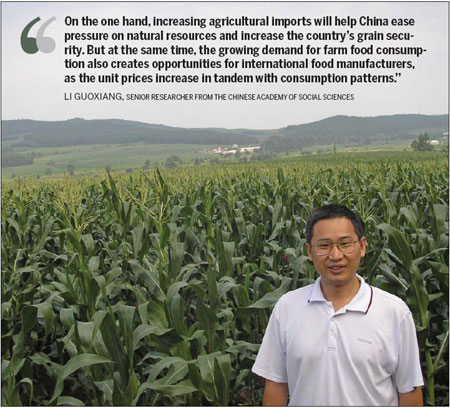A lot on the plate

 |
| Li Guoxiang from the Chinese Academy of Social Sciences expects a golden window of 5-10 years for food imports. Photos Provided to China Daily |
| From left: Liu Qiangde, deputy general secretary of China Animal Agriculture Association; Marcos Neves, professor at School of Economics and Business, University of Sao Paulo; and Ma Wenfeng, senior analyst at Beijing Orient Agribusiness Consultant. Photos Provided to China Daily |
Hogging the limelight
Pork imports have already hit the nadir and there seems to be no let-up in demand considering that domestic supplies are likely to remain constrained for some time.
"The gap between supply and demand is bound to increase within the next few years, despite an expected recovery from diseases and the reduction of small-scale pork farmers," says Wang Xiaoyue, a senior analyst at Beijing Orient Agribusiness Consultant Ltd.
"China's pork imports will continue to rise due to strong demand and competitive pricing on imports," he says.
The sharp decline in pork production last year had led to record imports. China's imports of pork and pork offal reached 1.35 million tons, up 50 percent over 2010, with the US being the largest exporter, accounting for more than half of the total volume, according to Customs.
At the same time, China has also become a top lure for meat exporters as demand has been climbing steadily. Most of the major pork exporting nations from Europe, North and South America are knocking on China's doors.
"As a country develops economically, the first quality of life aspect that improves at the household level is the carbohydrate to protein ratio in the daily diet. Greater economic prosperity among consumers in the mainland has directly translated into higher shares of animal protein such as pork," says Jorge Sanchez, director of agricultural trade office in the Consulate of the US in Guangzhou.
"An increase in pork consumption creates opportunities for US pork farmers, as the unit price increases are fueled by consumer demand."
Ma Chuang, deputy secretary-general of the China Animal Agriculture Association, says that China's surging demand for pork and pork offal implies an optimal export scenario because Chinese consumers tend to place higher value on pork offal, which is not eaten in Western countries. As a result overseas farmers can profit considerably from pork offal exports.
Cut above the rest
Unlike the high volume growth in pork imports, beef imports have been relatively slow. But with growing affordability and the demand for different food varieties, imported beef products are now finding more and more takers.
"At present, Chinese people are changing their diet patterns to higher and richer nutrition. As more Chinese prefer grass-fed animal meat with more protein, low fat and rich unsaturated fatty acids, beef is expected to replace some parts of the market share in pork, chicken and other meat consumption," says Liu Qiangde, deputy general secretary of the China Animal Agriculture Association.
In 2010, China became a net beef importer for the first time, importing 23,700 tons of beef and exporting 22,100 tons. Liu predicts that China will continue to import beef in the next five years, mostly from nations such as Australia, Uruguay and New Zealand.
China has banned beef imports from Japan and 13 European countries including the UK, France, Belgium and the Netherlands since 2001 and from the United States since late 2003, after the outbreak of mad cow disease in these countries. But Liu said China might lift the ban in the coming years in order to fill the ever-expanding gap between demand and supply.
In 2011, the mainland bought 33,900 tons of beef products from abroad, an increase of 10,200 tons from the previous year. Meanwhile, it also sold 17,700 tons of the meat products to Russia, the Middle East and Hong Kong, representing a drop of 4,400 tons from 2010, according to the US consulting company Frost & Sullivan.
Wang Yanzhi, chief representative of Mulligan International Group, an Australian farm company, says the retail price of beef in the domestic market is about 30 yuan ($4.8, 3.6 euros) per kg, while the imported variety from Australia sells at more than 200 yuan per kg. But higher price is not an issue, as Chinese consumers with higher income prefer Australian beef with marble lines that are more tender and lean.
"More and more Chinese are now looking for better and safer food nowadays. The Australian beef ensures an adequate supply of high quality beef products," he says.
At the same time, the growing demand for foreign beef is proving a threat to the local producers. "Beef production in China stands at about 5-6 million tons every year. This makes it difficult to keep pace with domestic demand, as cattle-breeding requires a lot of investment, and generally has a rather long production cycle of almost three years. Many farmers have also reduced their cattle herds due to potential risks," Liu says.
Irrespective of all the strides, beef still accounts for just 8 percent of the meat consumption in China, and comes far behind poultry and pork, representing 20 percent and 65 percent respectively. China's Ministry of Agriculture expects beef consumption to grow by another 1.5 million tons over the next decade.
Beef demand in China is likely to rise to 7.4 million tons in 2015, up 23 percent from 6 million tons in 2008, according to a report from the Amsterdam-based Rabobank.
Fresh catch
Despite the rapid strides made by the domestic marine products industry, aquatic food imports have been climbing steadily on the back of growing demand for premium products like lobster, geoduck, salmon and king crab.
"China's imports of aquatic products have increased steadily in terms of both value and volume as the nouveau riche prefer highly valued fish products due to their better nutritional value," says Cui He, executive vice-president of the China Aquatic Products Processing and Marketing Association.
He says that China's imports of aquatic products are expected to increase to 5 million tons within a few years, with the US, Canada, Australia, and Europe being the main suppliers.
In 2011, the volume of imported aquatic products climbed to 4.25 million tons from 3.82 million tons in 2010, up 11.3 percent. The value of these shipments reached $8 billion, an increase of 23 percent over the previous year.
Apart from aquatic products, China has also been importing more fresh and processed fruits from abroad, again driven by demand from the growing middle class.
Apples, table grapes and navel oranges are the three major fruit imports in China, but other fruits like Chilean cherries and Malaysian durians have their own niche markets.
Li Aoxue contributed to this story.
Contact the writer at lvchang@chinadaily.com.cn
Today's Top News
- China warns Japan against interference
- Nation's euro bond sale shows investors' confidence
- No soft landing for Tokyo's hard line
- Commerce minister urges US to increase areas of cooperation
- Strong demand for China's sovereign bonds signals global confidence
- Ministry urges Japan to 'maintain self-respect'































